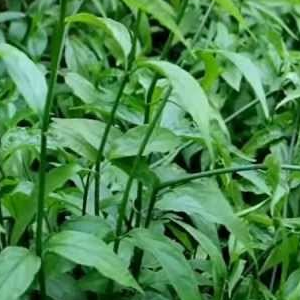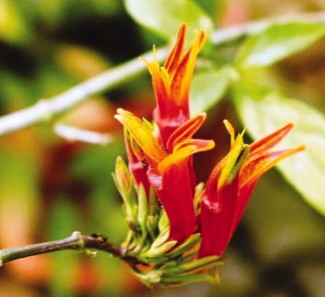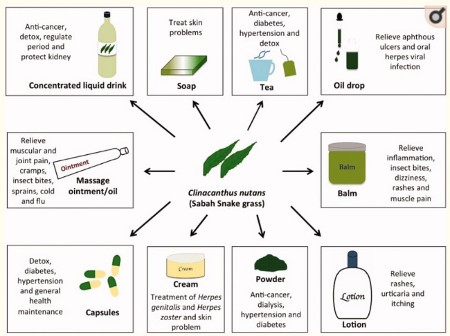Contents:
Common Names | Parts Usually Used | Plant(s) & Culture | Where Found | Medicinal Properties | Biochemical Information
Uses | Formulas or Dosages | How Sold | Nutrient Content | Resource Links
Scientific Names

- Clinacanthus burmanni
- Clinacanthus nutans
- Acanthaceae family
Common Names
- Alligator flower
- Belalai gajah (Malaysia)
- Dandang Gendis (Indonesia)
- E zuihua (China)
- Gendis (Indonesia)
- Ki tajam (Indonesia)
- Phaya plongtong (Thailand)
- Phaya yo (Thailand)
- Sabah Snake Grass
- Saled Pangpon Tua Mea (Thailand)
- Sha Be She Cao (Mandarin)
- Snake grass
- Twist of flowers
- You Dun Cao (Mandarin)
Parts Usually Used
All parts of the plant
Back to Top
Description of Plant(s) and Culture
Sabah Snake Grass is a perennial plant that grows to about 1 meter tall. It has yellow, red or green flowers that are about 3-4 cm in size.
Back to Top
Where Found
This plant is generally found growing in Indonesia, Malaysia, Africa, Brazil, and Central America.
Back to Top
Medicinal Properties
Snake grass exhibits antimicrobial, anti-inflammatory, anti-herpes simplex viral activity, antiviral, immune-boosting, antivenom, antioxidant, anti-dengue, antiproliferative and cytotoxic, and anti-diabetic properties.
Back to Top
Biochemical Information
This plant contains such bioactive compounds as glycosides, flavonoids, glycoglycerolipids, cerebrosides and monoacylmonogalatosylglycerol.
Back to Top
Uses

Medicinal uses of this plant include: as an anti-venom for snake, scorpion and insect bites; anti-VZV infection; treatment for skin rashes, varicella zoster, herpes simplex and herpes genitalis lesions, dysentery, as a diuretic, diabetes, dysuria, fever, gout, kidney syndrome, liver conditions, nasal conditions, cancer, menstrual issues, constipation, pain relief, anemia, jaundice, nettle rash, setting of fractured bones, benign growths, kidney problems, high blood pressure, high cholesterol, prostate inflammation, dengue virus, eczema, psoriasis, shingles, hematoma, contusion, strains and sprains and rheumatism.
Back to Top
Formulas or Dosages
A cream made using an alcoholic extract of dried leaves is used to relieve discomfort and heal herpes lesions.
An alcoholic extract using fresh leaves is used externally to treat snake and insect bites as well as skin rashes, HSV and VZV lesions.
Boiling fresh leaves to make a potent tea is a very common prescription for healing.
Sometimes, people mix leaf pulp with apple juice, sugar cane or green tea and consuming as a treatment.
.
Fresh leaves are crushed and applied to snakebites, scorpion stings or insect bites.
Fresh leaves are made into a cream for treatment of varicella zoster, herpes simplex and herpes genitalis lesions, pruritic rash, aphthous ulcers or burns.
For dysentary, use fresh leaves to make a decoction by boiling a handful of leaves in 5 glasses of water until the water level reduces to 3 glases in volume. The person should drink 1 glass daily.
To treat diabetes, boil 7–21 fresh leaves in 2 glasses of water until it reduces to the level of 1 glass. The person should drink 1 glass, twice a day.
As a treatment for dysuria, boil 15g of fresh leaves for 15 minutes. The person should drink this liquid once a day.
To take advantage of the proven anti-cancer effects of this plant, make a decoction of the fresh leaves boiled in water and drink daily.
There are three recipes for promotion of general health:
- Drink a decoction of fresh leaves boiled in water daily
- Drink the result of juicing fresh leaves with apple or sugarcane daily
- Soak dried leaves in water and drink daily
As an important treatment for cancer, juice fresh leaves with apple and lemon and drink daily. Here are some specific guidelines for this preparation:
- Stage 1: use 30 leaves per day in the juice preparation
- Stage 2: use 50 leaves per day in the juice preparation
- Stage 3: use 100 leaves per day in the juice preparation
- Stage 4: use 150–200 leaves per day in the juice preparation
High cholesterol and high blood pressure are treated by juicing fresh leaves with apple and lemon and drinking daily.
As a treatment for kidney problems, juice fresh leaves with dates and black soybean and drink the resulting liquid.
To help with urinary issues, kidney problems or prostate inflammation, juice the fresh leaves with green apple and drink daily.
To aid with eczema, psoriasis or shingles, make a decoction with the fresh leaves and stems combined with the leaves of Rhinacanthus nasutus and add to bath water.
Another treatment for eczema, psoriasis or shingles involves making a decoction by combining the fresh leaves with leaves of Polygonum Chinensis and boiling in water. Drink daily.
This image is reported by NCBI as a reference for treatment formulas using this plant:
How Sold
A number of forms of this plant are available for medicinal use such as cream, lotions, capsules, tablets, herbal tea, concentrated extract and secondary metabolites.
Back to Top
Nutrient Content
Nutrients contained in the snake grass plant are: Vitamins C and B1, Potassium, Calcium, Sodium and Copper.
Resource Links
Recent Studies Show Seven Herbs Help Stop Cancer Growth
Futurity.org: These Medicinal Plants Put Brakes on Cancer Growth
National University of Singapore: Anti-cancer properties uncovered in plants
Clinacanthus nutans: A review of the medicinal uses, pharmacology and phytochemistry

